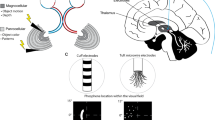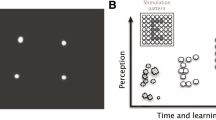Abstract
The question of what happens to the brain following the loss of sight is of seminal importance for any rehabilitative strategy for the blind. In order to interact effectively with their environment, blind individuals have to make striking adjustments to their loss of sight. Growing experimental evidence now suggests that these behavioral adaptations are reflected by dramatic neurophysiological changes at the level of the brain and specifically, with regions of the brain responsible for processing vision itself. These changes may represent the exploitation of spatial and temporal processing inherent within occipital visual cortex that allow a blind individual to adapt to the loss of sight and remain integrated in highly visually-dependent society. The modulation of such plasticity will be crucial in developing and projecting the success of future visual neuroprosthetic strategies and have important implications for rehabilitative training and device development.
This work was supported by a research grant of the Spanish Blind Organization (ONCE) and by the Bidons Egara Research Chair of the University Miguel Hernández.
Access this chapter
Tax calculation will be finalised at checkout
Purchases are for personal use only
Preview
Unable to display preview. Download preview PDF.
Similar content being viewed by others
References
Fernandez, E., et al.: Development of a cortical visual neuroprosthesis for the blind: the relevance of neuroplasticity. J. Neural Eng. 2(4), 1–12 (2005)
Alfaro, A., Fernandez, E.: Transcranial magnetic stimulation: contributions to the study of the visual pathway. Rev. Neurol. 46(5), 282–288 (2008)
Alfaro, A., et al.: An atypical presentation of visual hallucinatory experiences following prolonged blindness. Neurocase 12(4), 212–215 (2006)
Normann, R.A., et al.: Toward the development of a cortically based visual neuroprosthesis. J. Neural Eng. 6(3), 35001 (2009)
Fernandez, E., et al.: Mapping of the human visual cortex using image-guided transcranial magnetic stimulation. Brain Res. Protoc. 10, 115–124 (2002)
Fernandez, E., et al.: Mapping of the human visual cortex using image-guided transcranial magnetic stimulation. Brain Res. Protocols 10, 115–124 (2002)
Bernabeu, A., et al.: Proton magnetic resonance spectroscopy ((1)H-MRS) reveals the presence of elevated myo-inositol in the occipital cortex of blind subjects. Neuroimage (2009)
Alonso-Alonso, M., Fregni, F., Pascual-Leone, A.: Brain stimulation in poststroke rehabilitation. Cerebrovasc Dis. 24(suppl. 1), 157–166 (2007)
Bach-y-Rita, P.: Tactile sensory substitution studies. Ann. N. Y. Acad. Sci. 1013, 83–91 (2004)
Ferrandez, J.M., et al.: Brain plasticity: feasibility of a cortical visual prosthesis for the blind. In: Hernandez Muela, S., Mulas, F., Mattos, L. (eds.) Proceedings of the 25th Annual International Conference of the IEEE Engineering in Medicine and Biology Society
Hernandez Muela, S., Mulas, F., Mattos, L.: Functional neuronal plasticity. Rev. Neurol. 38(suppl. 1), 58–68 (2004)
Pascual-Leone, A., et al.: The plastic human brain cortex. Annu. Rev. Neurosci. 28, 377–401 (2005)
Merabet, L., et al.: Feeling by sight or seeing by touch? Neuron 42(1), 173–179 (2004)
Merabet, L.B., et al.: What blindness can tell us about seeing again: merging neuroplasticity and neuroprostheses. Nat. Rev. Neurosci. 6(1), 71–77 (2005)
Ptito, M., Kupers, R.: Cross-modal plasticity in early blindness. J. Integr. Neurosci. 4(4), 479–488 (2005)
Froemke, R.C., Merzenich, M.M., Schreiner, C.E.: A synaptic memory trace for cortical receptive field plasticity. Nature 450(7168), 425–429 (2007)
Dreher, B., Burke, W., Calford, M.B.: Cortical plasticity revealed by circumscribed retinal lesions or artificial scotomas. Prog. Brain Res. 134, 217–246 (2001)
Author information
Authors and Affiliations
Editor information
Editors and Affiliations
Rights and permissions
Copyright information
© 2013 Springer-Verlag Berlin Heidelberg
About this paper
Cite this paper
Alfaro, A., Fernández, E. (2013). Visual Neuroprosthesis: The Relevance of Plasticity. In: Pons, J., Torricelli, D., Pajaro, M. (eds) Converging Clinical and Engineering Research on Neurorehabilitation. Biosystems & Biorobotics, vol 1. Springer, Berlin, Heidelberg. https://doi.org/10.1007/978-3-642-34546-3_64
Download citation
DOI: https://doi.org/10.1007/978-3-642-34546-3_64
Publisher Name: Springer, Berlin, Heidelberg
Print ISBN: 978-3-642-34545-6
Online ISBN: 978-3-642-34546-3
eBook Packages: EngineeringEngineering (R0)




